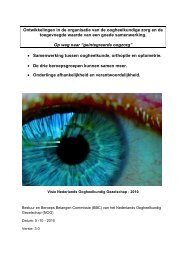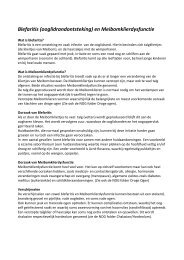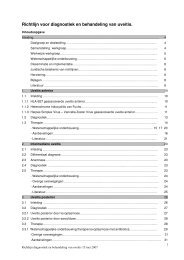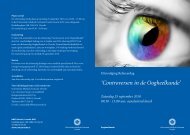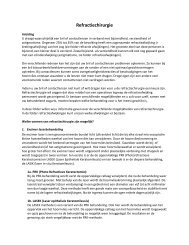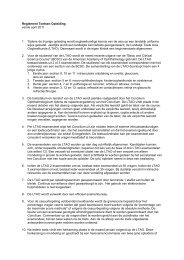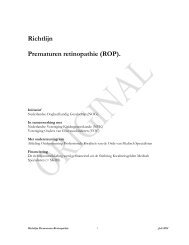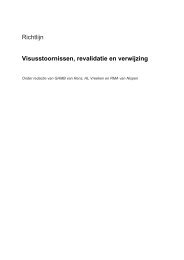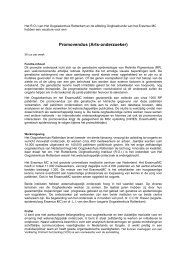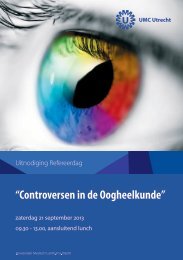terminology and guidelines for glaucoma ii - Kwaliteitskoepel
terminology and guidelines for glaucoma ii - Kwaliteitskoepel
terminology and guidelines for glaucoma ii - Kwaliteitskoepel
Create successful ePaper yourself
Turn your PDF publications into a flip-book with our unique Google optimized e-Paper software.
1.3.2.c - Rim/disc ratio (RDR)<br />
The fractional decimal value obtained dividing the rim thickness by the disc diameter. The closer the value is to 1,<br />
the better the optic disc appearance. It can be calculated as vertical diameters as <strong>for</strong> the cup/disc ratio but obviously<br />
with the opposite meaning, as rim area/disc area ratio (RDR or R/D). This latter can also be calculated <strong>for</strong> each degree<br />
of the optic disc as a sector index of a healthy disc.<br />
1.3.2.d - Retinal Nerve Fiber Layer Height (RNFLH)<br />
The thickness of the RNFL depends on disc area, age, stage of the <strong>glaucoma</strong>tous damage. It has been shown that vertical<br />
polar sectors were thicker than nasal <strong>and</strong> temporal. It was also shown that RNFL height in normal was thicker<br />
than in <strong>glaucoma</strong>tous subjects 16,22 .<br />
1.3.3 - RECORDING OF THE OPTIC NERVE HEAD (ONH) FEATURES<br />
Colour disc photos are useful <strong>for</strong> patient documentation.<br />
Colour photography with a 15° field gives optimal magnification.<br />
Stereoscopic photographs are the preferred method. Pseudo-stereoscopic photos are also acceptable.<br />
New systems <strong>for</strong> the ONH assessment, using alternative technologies, are being evaluated <strong>for</strong> reproducibility, specificity<br />
<strong>and</strong> sensitivity, although very few are currently available to the general ophthalmologist due to their cost (see<br />
Ch. 1.3.4).<br />
Drawings are better than nothing if a fundus camera is not available.<br />
Recording of the nerve fibre layer (NFL) features.<br />
The photographic methods require specialized processing of film. Patients must have clear media <strong>and</strong> photography of<br />
lightly coloured fundi are more difficult. The technique is available in some centres, though their use in routine clinical<br />
work is limited.<br />
New systems <strong>for</strong> NFL assessment, using alternative technologies, are being evaluated <strong>for</strong> reproducibility, specificity<br />
<strong>and</strong> sensitivity, although currently very few are available to the general ophthalmologist due to their cost (see Ch.<br />
1.3.4).<br />
1.3.4 - IMAGING IN GLAUCOMA<br />
Although clinical examination still remains the most important method of assessing the ONH <strong>for</strong> <strong>glaucoma</strong>tous damage,<br />
several imaging devices are now available, allowing quantitative measurements of nerve structure. This may aid<br />
clinical management 23 .<br />
These include confocal scanning laser ophthalmoscopy (e.g. Heidelberg Retina Tomograph (HRT)), scanning laser<br />
polarimetry (e.g. GDx), optical coherence tomography (e.g. OCT) <strong>and</strong> retinal thickness analyzer (e.g. RTA). Other<br />
methods of documentation of structure (e.g. stereo disc photography) are also widely used. In using these machines,<br />
accuracy <strong>and</strong> reproducibility of measurement is important, as well as the ability to discriminate between healthy <strong>and</strong><br />
<strong>glaucoma</strong>tous subjects, now very limited in early disease.<br />
It must be emphasized that the process of categorising patients by means of imaging device measurements is not<br />
the same as diagnosis. Diagnosis must also integrate all the other available in<strong>for</strong>mation about the patient, including<br />
clinical assessment of the ONH <strong>and</strong> RNFL, visual field <strong>and</strong> risk factors including IOP, age <strong>and</strong> family<br />
history.<br />
In the future, with greater clinical in<strong>for</strong>mation being provided by optic disc measurement <strong>and</strong> with the cost of the<br />
instruments declining, the clinical use of these devices is likely to exp<strong>and</strong>.<br />
1.3.4.1 - HRT<br />
The Heidelberg Retina Tomograph is a confocal scanning laser which uses a 670nm light source <strong>and</strong> can assess the<br />
optic nerve head by creating a threedimensional image 24-26 .<br />
1.3.4.2 - GDX<br />
The nerve fiber layer analyzer is a scanning laser polarimeter which uses a 780 nm polarized light source <strong>and</strong> can<br />
quantify the retinal nerve fiber layer thickness by measuring the retardation of the reflected light 27-29 .<br />
Ch. 1 - 20 EGS



